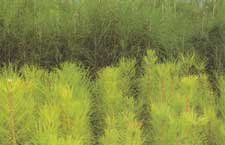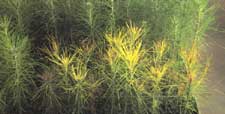Yellows, or ChlorosisSamuel J. Rowan - Principal Plant Pathologist (retired), Southeastern Forest Experiment Station, USDA Forest Service, Athens, GA. Cordell C.E., Anderson R.L., Hoffard W.H., Landis T.D., Smith R.S. Jr., Toko H.V., 1989. Forest Nursery Pests. USDA Forest Service, Agriculture Handbook No. 680, 184 pp. Hosts All green plants are susceptible to foliage yellowing, or chlorosis. Distribution The disease occurs throughout the temperate regions of the world. Damage The amount of growth reduction or mortality of seedlings depends upon the cause of the problem, the length of time the plants are chlorotic, and the degree of chlorophyll deficiency. Chlorosis is sometimes associated with rapid mortality of the root system and plant. At other times, severe symptoms for a brief period may cause only slight growth reductions. If it persists for several months, however, severe yellowing is likely to cause high mortality. In general, chlorotic seedlings are unusually sensitive to high or low temperatures, nematodes, fungi, bacteria, pesticides, and other factors. Diagnosis Chlorosis of seedlings may be caused by any of several factors, so the usual diagnostic procedure involves a process of elimination, with obvious and easily determined causes checked first. Look for excess soil water, insects, heat or cold injury, and fungal disease symptoms. Foliar and soil analysis will pinpoint any major nutritional deficiences. Biology The terms "yellows" and "chlorosis" are used to describe any physiological disturbance or disease of plants resulting in the yellowing or blanching of foliage (fig. 47-1). The destruction or reduced synthesis of chlorophyll may be caused by any number of biotic or abiotic factors, and two or more factors often combine to cause chlorosis of forest tree seedlings. The more common factors follow:
Control Biological - Mycorrhizal feeder roots will usually be replenished when the natural fungus inoculum source is adequate. However, artificial inoculations with selected ectomycorrhizal fungi may be required in some cases. Cultural - The removal of excess fertilizer or toxic chemicals from soil is often difficult and may require fallowing the contaminated area until the material has deteriorated or has been leached below the plant root zone. The mechanical removal of chemically contaminated soil from some seedbeds may be required. Control viral, mycoplasmic, and certain bacterial diseases by removing infected seedlings from the nursery. Reduce air and soil temperatures by mulching, shading, and irrigating seedbeds. Ensure that soil drains properly to eliminate excess soil water. Correct nutrient deficiencies by applying the requisite mineral element(s) to the foliage or soil. Chemical - Root diseases can be controlled by fumigating the soil with methyl bromide or other fumigants before sowing seeds. Foliage and stem pathogens can be controlled with fungicidal foliar sprays. Insects and mites can be controlled with insecticides. Selected References Filer, T.H. Jr.; Cordell, C.E. 1983. Nursery diseases of southern hardwoods. For. Insect & Dis. Leafl. 137. Washington, DC: U.S. Department of Agriculture. Forest Service. 6 p. Hacskaylo, J.; Finn, P.F.; Vimmerstedt, J.P. 1969. Deficiency symptoms of some forest trees. Res. Bull 1015. Wooster. OH: Ohio Agricultural Research and Development. 69 p. Hodges, Charles S., Jr.; Ruehle, John L. 1979. Nursery diseases of southern pines. For. Pest Leafl. 32. Washington, DC: U.S. Department of Agriculture. Forest Service. 8 p. |
Forest Pests: Insects, Diseases & Other Damage Agents |

|
|



